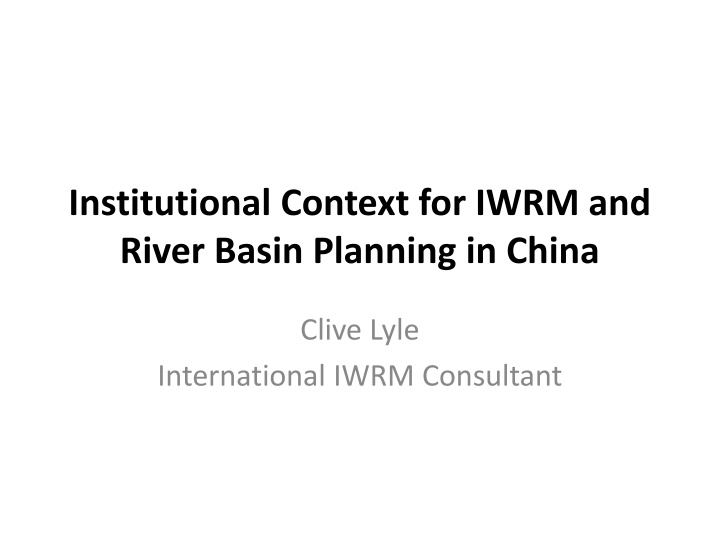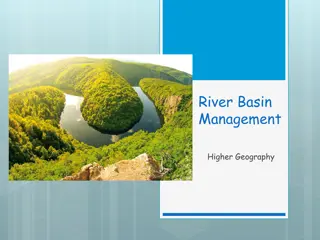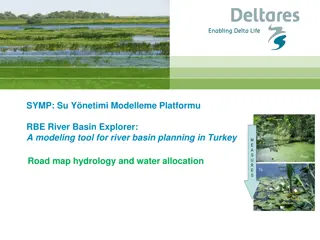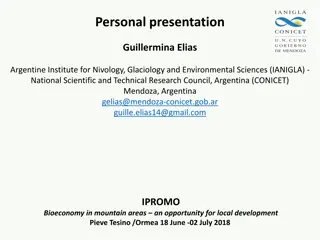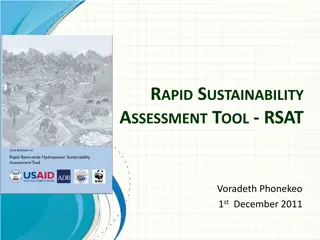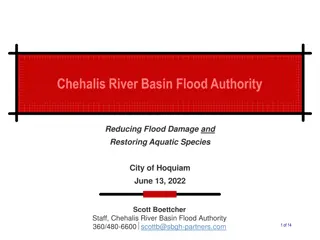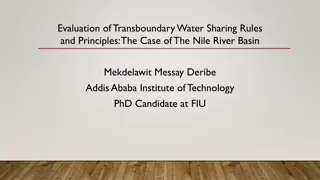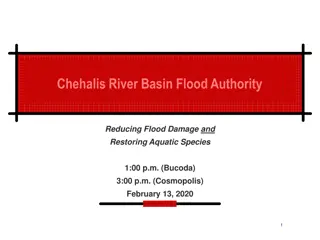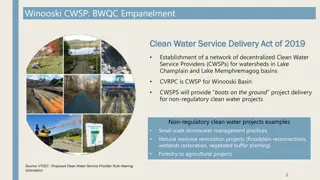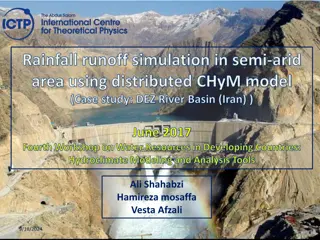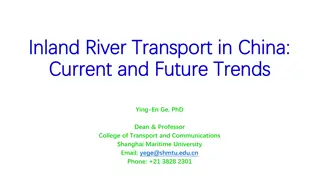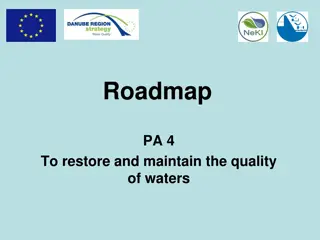River Basin Planning and Administration in China
In China, river basin planning and administration are crucial for managing water resources effectively. The country has seven national-level river basins, each with its River Basin Commission responsible for coordinating water resource management. Examples like the Yellow River and Haihe Basin highlight challenges such as water scarcity, pollution, and the need for transboundary cooperation. Efforts are being made to rehabilitate and mitigate the serious impacts on the environment, particularly in regions like the Bohai Sea.
Download Presentation

Please find below an Image/Link to download the presentation.
The content on the website is provided AS IS for your information and personal use only. It may not be sold, licensed, or shared on other websites without obtaining consent from the author.If you encounter any issues during the download, it is possible that the publisher has removed the file from their server.
You are allowed to download the files provided on this website for personal or commercial use, subject to the condition that they are used lawfully. All files are the property of their respective owners.
The content on the website is provided AS IS for your information and personal use only. It may not be sold, licensed, or shared on other websites without obtaining consent from the author.
E N D
Presentation Transcript
Institutional Context for IWRM and River Basin Planning in China Clive Lyle International IWRM Consultant
National Level River Basin Administration in China For administrative purposes there are 7 National level River Basins : Songhua RB 1.Yellow River Basin (also responsible for inland basins) 2.Haihe Basin 3.Huaihe Basin 4.Songliao River Basin Yangtze River Basin 5.Yangtze River Basin 6.Taihe Basin (lower Yangtse RB) 7.Pearl River Basin The River Basin Commissions are units of the Ministry of Water Resources with their offices located within the respective river basin.
The Yellow River Example 11 Provinces (States) in the Basin making it transboundary as Provinces have major water resource management responsibilities Key water resource issues are water scarcity, flooding, sedimentation, pollution and environmental degradation Zero flow occurred in the lower reaches in 21 years out of 27 years from 1972 to 1999 for a total no flow period of 1,091 days Management of the river is shared between the YRCC and the Provinces In essence, the YRCC establishes Provincial water allocations (both long term allocation scheme and then annual and emergency/drought plans) in consultation with Provinces The allocation is approved by the State Council Provinces then allocate water internally consistent with the overall scheme and their quota Responsibilities for mainstream and tributary regulation mostly rest with the Provinces- some exceptions especially for larger reservoirs and flood control
The Haihe Basin and Bohai Sea Example Perhaps the most water scarce and polluted river basin in China Some question as to whether it can really be rehabilitated (especially the pollution) Surface water being transferred in from the Yangtze river basin (South to North Transfer)
Serious Impacts on the Bohai Sea Severe pollution from industry, urban growth and agriculture in Basin rivers 1999- 10 Along with the much reduced river flow into the rivers, the Bohai Sea is polluted causing red tides and depleting the fishery
Hai Basin- Institutional Arrangements 7 Provincial level governments making it transboundary Hai Basin Commission under the MWR mostly concerned with water sharing and conservation. Similar to YRCC Ministry of Environment (since 2008) with the key role of pollution control In order to manage the problems in a better way MWR and MEP have formed a Joint Program Steering Committee MWR and MEP jointly plan basin management with some consultation with Provincial governments Harmonisationisation of water management function zones and environmental standards Implementation is by lower levels of government (Provinces, Municipalities, Counties)
The Shiyang Basin Example Situation Inland river basin within one Province Problems i. Over use of water ii. River system and terminal lake system dry for many years, iii. deserts and sand storms expanding, extreme poverty and poor living conditions iv. Groundwater use unsustainable
The Shiyang RB Example i. Formed RBO comprising Province and Municipality members ii. Comprehensive RB plan that involved: Water allocation and permits Strict Groundwater use control: closure of groundwater wells (about 7,000 wells of 20,000 wells) IC cards that control groundwater pump use and costs Water saving practices: canal lining, irrigation practices, agronomy, cropping patterns, reducing canal lengths to reduce evaporation Changed cropping patterns to increasing farmer incomes Pollution control (via Environment Department)
Shiyang Basin Institutional Arrangements Gansu Provincial Government Shiyang River Basin Commission i. Provincial Vice Governors (Vice-Ministers) ii. Directors of Gansu Departments iii. Municipality Vice Mayors (3) Shiyang Basin Management Bureau Wuwei Municipality Jinchang Municipality Zhangye Municipality COUNTIES VILLAGE WATER USER ASSOCIATIONS
Some concluding comments on the Chinese approach to River Basin management Uncontrolled and rapid industrial and urban development can rapidly deplete the resource Once this degradation has happened it is difficult and expensive to correct (especially the pollution) Need for pre-emptive action River basin units are recognised as the necessary unit for planning the sharing of water, the management of drought and part of the solution for pollution management
Some concluding comments (2) There are 2 main models used (i) the more top down consultative model shown by the national level River Basin Commissions (ii) the newer cooperative, participative approach shown by the lower level RBOs Both seem to work reasonably well. Is one better? The RBO are effective compared to many in other countries probably because they have decision making powers and responsibilities. But mostly top down. The nested approach (National-Province-County-WUA) to water resource management is effective and ensures Basin level planning connects to water users
Some concluding comments (3) Responsibilities for policy and planning, and service provision such as river operations, and water supply to end users fairly clearly separated and accountable Management of surface water and groundwater resources are in one agency enabling strong and integrated management Chinese agencies have a very strong focus on action and the end results They have managed to keep the approaches fairly simple, practical and to address the important issues
Some concluding comments (4) Characteristic of Good IRBM Progress Water Laws Recent, clear and comprehensive Policies to control water sharing and pollution Mostly good Enforcement variable Some water trading takes place with basic entitlements Involvement of agencies in river basin management Relevant agencies involved in more recent RBOs Difficult to achieve other agencies direct involvement (eg. environment, forestry) without prescriptive laws River basin plans Mostly effective and focussed on results Being funded and implemented Willing to make difficult decisions Innovative approaches being used Data and information between agencies Mostly reasonable data Limited sharing between agencies Participation and engagement of water users Generally limited although the administrative system enables bottom up feedback Users involved in implementation as needed Financing of infrastructure O&M Industry and urban tariffs collected Agriculture contributes water user fees for O&M
